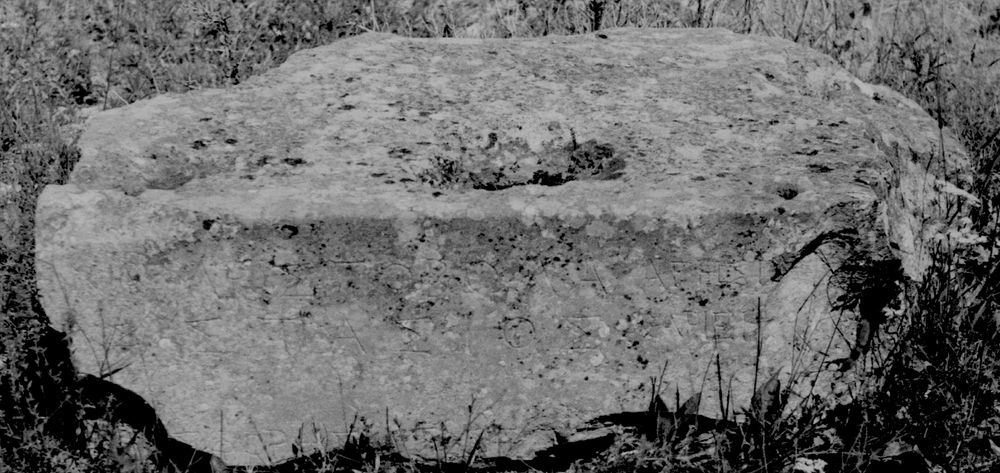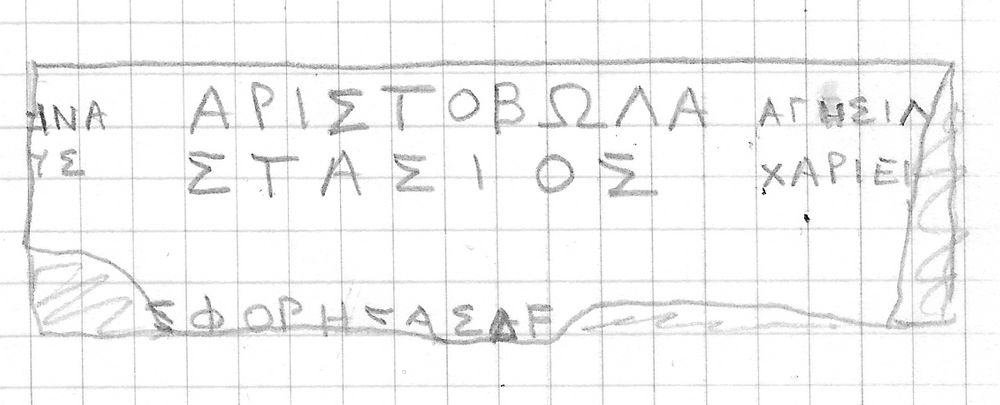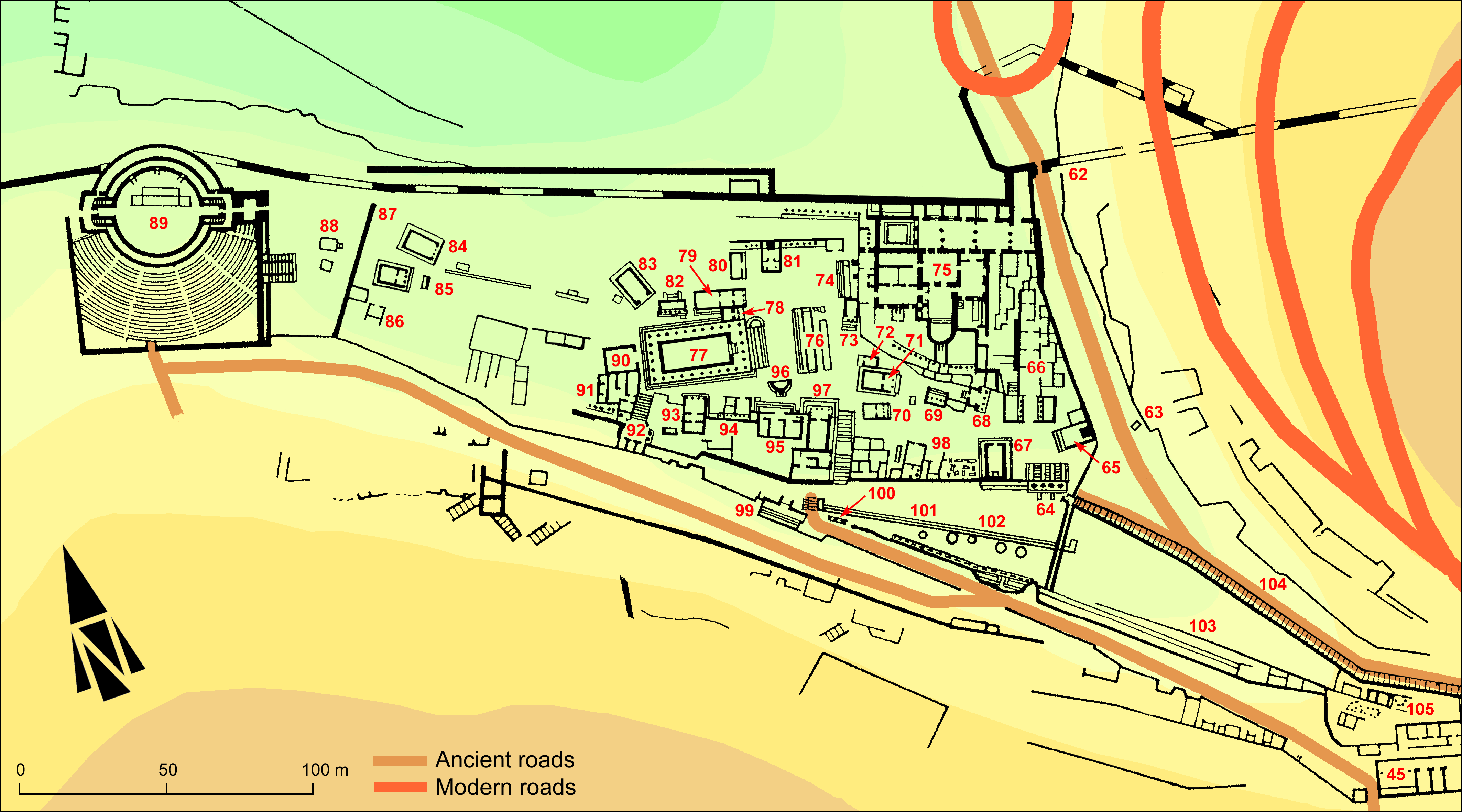EpiDoc XML:
IGCyr1046002
Trismegistos ID:
738568
Source description
Support: Limestone block with on top several holes for accomodation of statues and dowel holes for adjoining another block to the left; the preserved block is broken off at right end of front face and at both ends of lower edge (w: 0.96 × h: 0.24 × d: 0.77). If a similar block is lost at left, the whole monumental base would have measured nearly w: 2 metres.
Layout: Inscribed on front face in five columns (of which only c, d, e survive) of two lines each in correspondance with the statues, forming textpart i). Below is texpart ii) in one line running on the whole width.
Letters: 0.03 at lines 1-2 of c, e; 0.035 at lines 1-2 of d; 0.03 at line 3; finely cut letters, with various spacing so as to have the same width at both lines of each column; slight serifs, broad eta, slightly smaller omicron, more or less slanting sigma, flattened loop of phi.
Date: End of third century BC (lettering).
Findspot: Found in 1933 at Cyrene ➚: Sanctuary of Apollo, East of the Greek Theatre.
Place of origin: Findspot.
Last recorded location: Seen by D. Morelli in 1960 inside the Sanctuary of Apollo. Seen by C. Dobias-Lalou in 1983 and again 2001 between Nicodamos' wall and the Greek theatre. Seen by E. Rosamilia in 2010 at the same place.
Text constituted from: Transcription from stone (CDL).
Bibliography
Morelli in SECir, 252 (no image); IGCyr 104600 ➚; Rosamilia 2023, pp. 196-197 (typology), pp. 375-376, number 103 (text).
Cf. Dobias-Lalou – Maffre 2018, whence SEG 68.1746.
Text
Apparatus
i.a.1-2: [---] | [---] Rosamilia 2023: SECir, IGCyr column not restored
i.b.1-2: [Χαριείδης?] | [---] Rosamilia 2023: SECir, IGCyr column not restored
i.c.1: [Ἀριστοξ?]ήνα Rosamilia 2023: [---ξ]ήνα; [---]ηνα SECir
i.c.2: [Χαριείδε?]υς IGCyr, Rosamilia 2023: [---]+υς SECir
i.e.2: Χαριείδ̣[ευς] IGCyr, Rosamilia 2023: Χαριειδ̣[---] SECir
ii: [Χαριείδης? c. 7 - 9] [c. 5 - 7ια]: [Χαριείδης? --- Καρνεῖα] Rosamilia 2023; [Χαριείδης? --- Ἀρταμίτια] Rosamilia 2023; [---] SECir, IGCyr
French translation
[Untel, fils d'Un tel].
[Kharieidès? fils d'Un tel].
[Aristo?]xèna fille de [Kharieid]ès.
Aristobôla fille de Stasis.
Hagèsidamos fils de Kharieidès.
[Kharieidès, fils d'Un tel], après avoir accompli la télesphorie [des Karneia/ des Artamitia, a consacré] (scil. ce monument) au titre de la dîme.
English translation
[So-and-so, son of So-and-so].
[Charieides? son of So-and-so].
[Aristo?]xena daughter of [Charieid]es.
Aristobola daughter of Stasis.
Hagesidamos daughter of Charieides.
[Charieides, son of So-and-so?], after having achieved the telesphoria [of the Karneia/Artamitia, dedicated] (scil. this monument) as a tithe.
Italian translation
[Il tale, figlio d'il tale].
[Charieides? figlio d'il tale].
[Aristo?]xena figlia di [Charieid]es.
Aristobola figlia di Stasis.
Hagesidamos figlia di Charieides.
[Charieides, figlio d'il tale?], dopo aver concluso la telesphoria [delle Karneia/Artamitia, ha dedicato] (scil. questo monumento) come decima.
Commentary
There is something unclear in Morelli's explanations about the provenance. He writes that the stone was found East of the Greek Theatre and had been brought in 1960 inside the Sanctuary of Apollo. However it stood in 1983 (and still en 2001) East of the Greek theatre in vicinity of IGCyr0979002.
The inscription on this base is made of two parts: textpart i) is a series of captions corresponding to the statues standing above and providing their names at the nominative; textpart ii) is the dedication formula. Insisting on the lost block at left, Rosamilia 2023 completes the overview of the monument that was described at IGCyr.
The name of the woman at column b) is highlighted by the larger dimension of the letters and its central position. In correspondance with the multiple holes on top, it is very plausible that her statue stood in the middle and that smaller statues stood at both sides, the mention at left being cut across the two blocks. Symmetrically, a man's statue whould have stood in the middle of the left block and the statue of another child at far left.
The damaged names may be fully or partly restituted: the father's name at column b) is easy to complete as Χαριείδης and the ending of the father's name at column a) was probably the same. If so, the mother would have been surrounded by her two children, while her husband would be the dedicant. For the daughter's name (c) Rosamilia's Aristoxena is very plausible, both for the number of letters and for the relation with the mother's name. The reverse name Ξεναρίστα is known from IGCyr0242002.
Stasis, the father's name of Aristobola, is also well represented in IGCyr0979002 and shows probably some relation between the two families. It is a similar base, placed in the vicinity and offering the same use of the nominative case of the persons featured upon it, followed by a full sentence mentioning the dedicant. However, only this one is dedicated as a tithe and on behalf of telesphoria. Being somewhat later than the other and somewhat less spectacular, the present base was probably modelled on the former.
CC BY-NC-SA 4.0 Deed Attribution-NonCommercial-ShareAlike 4.0 International License.
All citation, reuse or distribution of this work must contain a link back to DOI: https://doi.org/10.60760/unibo/igcyrgvcyr2 and the filename (IGCyr000000 or GVCyr000), as well as the year of consultation.



